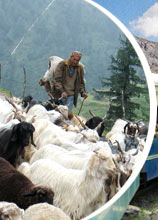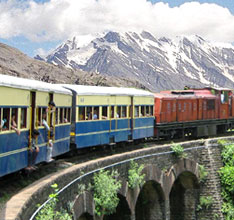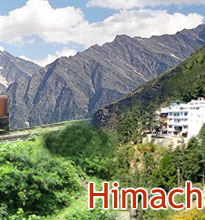 Kullu
is an ancient town of Himachal Pradesh, which finds a mention in the
religious texts, such as Vishnu Purana, Ramayana and Mahabharata, as
'Kulantpitha'. The town also served as the home of Rishi Shringi, who
performed the yajna for Raja Dashrath that led to the birth of Lord Rama
and his brothers. In Mahabharata too, it is mentioned that Pandavas
visited the place thrice. 'Kulantpitha' means 'the end of the habitable
world', which seems appropriate as beyond Kullu, there are only the high
Himalayas.
Kullu
is an ancient town of Himachal Pradesh, which finds a mention in the
religious texts, such as Vishnu Purana, Ramayana and Mahabharata, as
'Kulantpitha'. The town also served as the home of Rishi Shringi, who
performed the yajna for Raja Dashrath that led to the birth of Lord Rama
and his brothers. In Mahabharata too, it is mentioned that Pandavas
visited the place thrice. 'Kulantpitha' means 'the end of the habitable
world', which seems appropriate as beyond Kullu, there are only the high
Himalayas.The hill station boasts of a number of splendid valleys and breathtaking views of the mountains, making it a visual delight. It is said that in the 17th century, Raja Jagat Singh brought an idol of Lord Raghunathji to Kullu, from Ayodhya. He placed it on the throne, as the King of Kullu, and ruled the state only as His Prime Minister. The royal family of Kullu kept on following this tradition till Independence. Today, Lord Raghunathji is revered as the presiding deity of the Kullu valley of India.
Isolated from the rest of the world by the high Himalayan ranges, Kullu rulers had their original capital in the ancient village of Jagatsukh, near Manali. Since the valley was an important stopover and trading point on the route to Lahaul and Ladakh, it greatly prospered with time. By 17th century, it had expanded to Lahaul-Spiti in the north and the Sutlej River in the east. The rulers then shifted their capital first to Naggar, then to Sultanpur and finally Raja Jagat Singh chose Kullu as his capital.
After independence, it became the district headquarters and is still an important trade center of the region. Situated at a distance of approximately 40 km from Manali, Kullu is a popular stopover point for tourists visiting Manali and trekkers targeting the trek routes of the Parvati valley and the Pin valley. The beauty of the valley has led to it being called as the 'Valley of Gods'. People here are warm and friendly and deodar and pine forests surrounding the area, giving it a paradisiacal look. The natural beauty and scenic splendor of Kullu has contributed immensely to the growth of its travel and tourism industry.
Kullu Tourist Attractions
Kullu valley is located in Himachal Pradesh, near the beautiful hill station of Shimla. With the mighty Himalayas forming as its backdrop, the valley looks like a picture straight out of a fairytale. Comprising the major tourist attractions of Kullu are its exquisite temples, which attract tourists from various parts of India as well as abroad.
Tabo Monastery
Tabo Monastery is situated in the Spiti Valley of Himachal Pradesh. The great teacher and translator Rinchen Zangpo founded the monastery in 996 AD and till today, it holds the distinction of being the largest monastic complex in the Spiti region.
Sujanpur Fort
Situated in the Hamirpur district, Sujanpur Fort stands tall on the banks of River Beas. This fort, being perched on top of a hill, is popularly known as 'Tira' and was built by Raja Abhaya Chand in 1758.
Bijli Mahadev Temple
Bijli Mahadev, the temple dedicated to Lord Shiva, is located across the river Beas, at some ten kilometers distance from Kullu. It is adorned with a staff that is sixty feet high and is visible from near by Kullu and Parvati valleys also.
Places To See near Kullu
Flanked by beautiful Himalayan peaks and awe-inspiring natural vistas, Kullu is an awesome travel destination. Known as the ‘Valley of Gods’, it boats of a large number of tourist attractions.
How to Reach Kullu
Kullu, located in the lap of nature and boasting of a pristine climate, is a major tourist attraction in North India. Pilgrims, trekkers, and other frequent travelers flock in large number to this tourist spot.
Kullu Weather
Kullu valley forms one of the most visited hill stations in India, owing to its pleasant weather and exquisite natural beauty. The place has three seasons in a year. Every season has its charm here and gives it a beauty in its own entirety.








